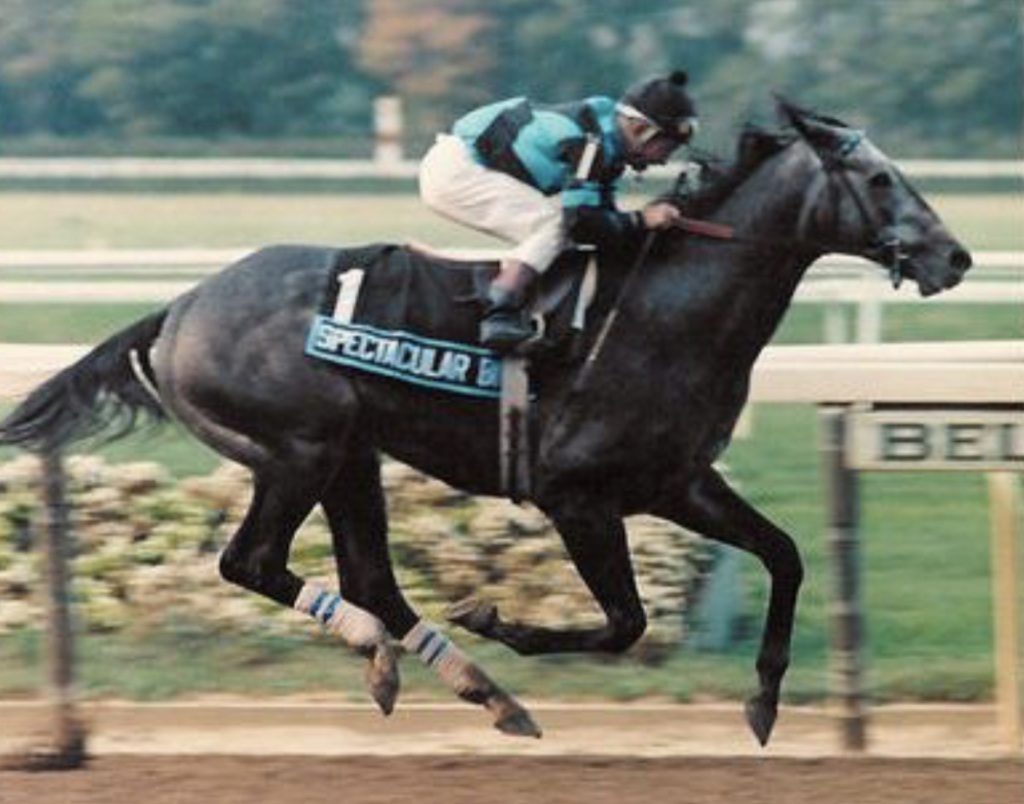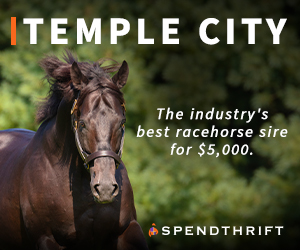
By Kate Richards
The colt was the color of grey described as steel that could seem silvery in direct sunlight yet became almost off black after a particularly hot race. Upon his death at the age of 20, he had matured to a white-coated retiree, always friendly, especially if one sought him out with his favorite jelly donuts.
The son of Bold Bidder, he was bred, foaled and auctioned in Kentucky and then purchased by a real estate developer from Baltimore, Harry Meyerhoff, racing under the blue silks of Harry’s Hawksworth Farm in association with his son, Tom, and his then-wife, Teresa. If one asked Harry about the institution and the clannishness of racing, he would wink, chuckle and proclaim himself as an outsider who got lucky with his $34,000 purchase of SPECTACULAR BID, almost named “Seven No Trump”. Harry had been an All-American lacrosse player at Lehigh University as well as a tournament bridge player and embodied an unusual combination of modesty, competitiveness and good humor. The horse, much like his owner, was up for his subsequent success in the years when the golden progeny of his grand-sire, Bold Ruler, stamped generations of racehorses like Secretariat, and then through subsequent generations as A.P. Indy, Bold Commander and the Bid’s sire, Bold Bidder. Once, I asked Harry about the Bid’s illustrious breeding, he declared, “Spectacular Bid is an eastern shore horse.” *This writer worked for Harry and his family as a boat chef for several months and her boss was fond of telling the writer’s mother, that she made “good reservations”.
Spectacular Bid, to many insiders well versed in pedigrees, race records, and clocked works, was a phenomenon, his legacy as important as the one of Big Red, Secretariat. No less than eight times, the Bid broke or equaled track records. Out of thirty races contested, the Bid won twenty-six and this during racing’s ‘golden age’. Excepting the often-repeated Secretariat video of the 31 length Belmont triumph, the Bid’s legacy of record stands any comparison. Had he raced in the age of social media and fan groups; the rhapsodic postings would have rivaled those of California Chrome.
Harry Meyerhoff was so grateful for the hometown of Baltimore’s response to the Bid’s win at the Kentucky Derby that he planned for the colt’s last Preakness breeze to be opened to the public. Thousands of locals turned out to cheer the Bid’s work at Pimlico. For Harry Meyerhoff, the Preakness at Pimlico Racetrack was not just the second jewel in the series, it was the premier event for Maryland’s thoroughbred industry. After all, the Bid was “an eastern shore horse” and he was Maryland’s champion.
One of the most controversial episodes was the third leg of the Triple Crown, thwarted in his Belmont stall by his habit of picking at his pinned wraps. Whether his third-place finish was a product of jockey Ronnie Franklin’s ride or a latent infection from the pin and who-knew-what before-post-time, the Bid healed quickly and raced into a spectacular fourth year with his next jockey, Bill Shoemaker. Harry had given the apprentice, Franklin, his original shot and always remained loyal to the good things that Franklin accomplished. He was equally loyal to his trainer, Grover ‘Buddy’ Delp. Bid is thought of by many as the best horse not to win the Triple Crown. His walkover in the 1980 Woodward at Belmont Park showed just how feared he was on the track as no horse’s connections wanted to load their charge in the gate with him.
SPECTACULAR BID remains an exception in the record books as he was an Eclipse winner at two, again at three and in his finest campaign, as champion older male at four. Both the horse and his owners remain a credit to Maryland racing.
They say great horses can overcome trouble, bad trips, bad rides and more. There may be no better example than of this than Spectacular Bid’s 1979 Florida Derby. You can watch it here:
Always check with Past the Wire for the latest horse racing news…..



